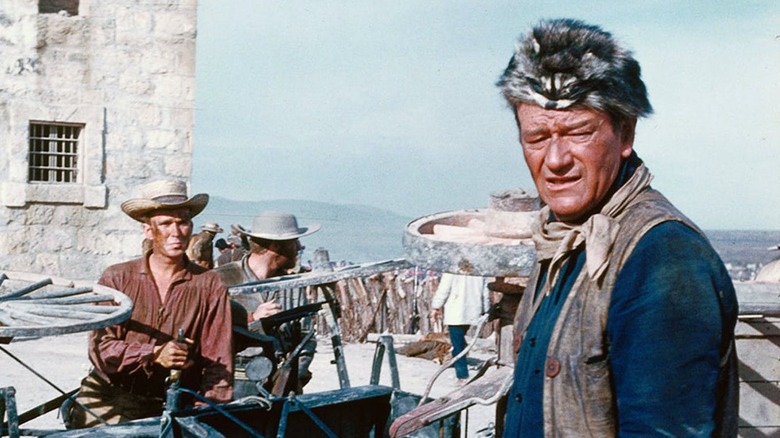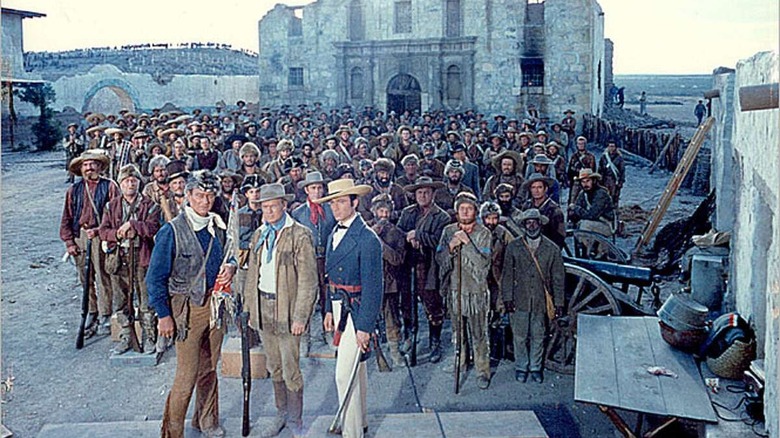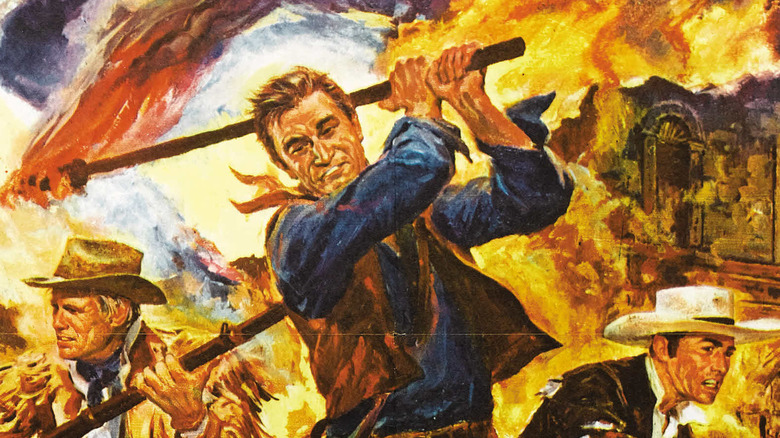The Lingering Guilt That Inspired John Wayne's The Alamo
It's rare that you can pinpoint the exact moment an actor vaults from regular old leading man to bona-fide cultural icon, but that's exactly what you're seeing when John Wayne, abetted by an audacious push-in from director John Ford, spins that 1852 Winchester rifle in his introduction as The Ringo Kid in "Stagecoach." Henceforth, Wayne was the epitome of the American male, the flesh-and-blood ideal of decisive action, an ornery maverick who tamed the West and served his country valiantly in wartime. Just about every boy and man in the country wanted to be John Wayne. But as his career wore on, it's possible that nobody wanted to be John Wayne more than John Wayne.
When the United States declared war on Japan in response to the bombing of Pearl Harbor, some of Hollywood's biggest names rushed to serve their country. Megastars like James Stewart and Henry Fonda placed their thriving careers on hold to join the war effort (the former flew bombing missions over Nazi-occupied Europe, while the latter saw action as a Quartermaster on the USS Saterlee). Some of the industry's most celebrated filmmakers pitched in to bring the Allied war effort home to the nation's movie theaters (if you've never read or watched Mark Harris's "Five Came Back," please remedy this posthaste). The fate of the civilized world hung in the balance. No one, provided they were of sound mind and body, got to sit this out. John Wayne checked those boxes, yet John Wayne did not serve.
However, as alleged expiation for his sin of inaction, John Wayne did make "The Alamo." How did that work out? Well...
Hold me back, boys
Wayne never enlisted, but, according to Randy Roberts and James S. Olson's biography "John Wayne: American," he did make a heckuva lot of noise about wanting to do so. Though he was, at the age of 34, too old at the start of the war to be conscripted, Wayne was eventually reclassified as 1-A. Given his vital importance to the oater factory that was Republic Pictures, the company apparently kiboshed any attempt to draft their biggest star. Wayne repeatedly wrote to his friend and frequent collaborator Ford, asking if he could join the filmmaker's production unit. There is also, per Magnum On Set's article on the making of "The Alamo," evidence that Wayne put off joining up until after "he finished just one or two pictures."
In any event, regardless of how many letters Wayne wrote to Ford claiming he wanted to serve his country during World War II, he never did. This is in marked contrast to Henry Fonda, who plainly stated "I don't want to be in a fake war in a studio" before joining the Navy.
A bitter atonement
Wayne had been hot to make his directorial debut via a film about the battle of The Alamo since 1945 (perhaps not so coincidentally, the year World War II ended), but it wasn't until he formed his own production company, Batjac, that he was able to seriously pursue the project to his epic, three-hour-long specifications. Even then, he had to compromise. United Artists was willing to kick in $2.5 million, but only on the condition that Wayne star in the film as well. Wayne relented and took the role of Davy Crockett. After hitting up wealthy Texans and coming out of his own pocket to the tune of $1.5 million, "The Alamo" commenced production in 1959. Though the finished movie performed decently at the box office, Wayne had to sell the rights to UA to get his money back.
For a film supposedly motivated by patriotic guilt, "The Alamo" is a slog of overcompensation. You want to get sucked in by William Clothier's 70mm Todd-AO cinematography, but Wayne is less interested in visuals than the didactic dialogue of his favorite screenwriter, James Edward Grant. This isn't a movie about sacrifice. It's a long-winded jeremiad about the virtues of rugged individualism and the evils of communism. The speechifying is frequent and seemingly unending. It feels more like score-settling than atonement. While I do not doubt The Duke's widow, Pilar Wayne, when she says her husband "would become a 'superpatriot' for the rest of his life trying to atone for staying home," my most charitable read of "The Alamo" is that he simply wasn't a skilled-enough director to effectively convey his angst. Mostly, though, I think this is a bitter, boring movie by a man who resented the fact that he lacked the nerve to live up to his filmed legend.


